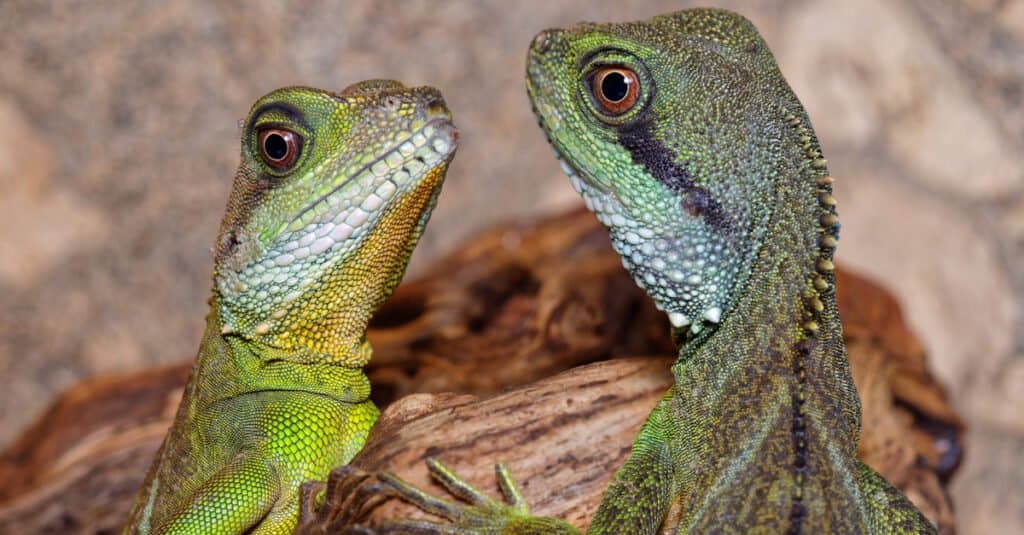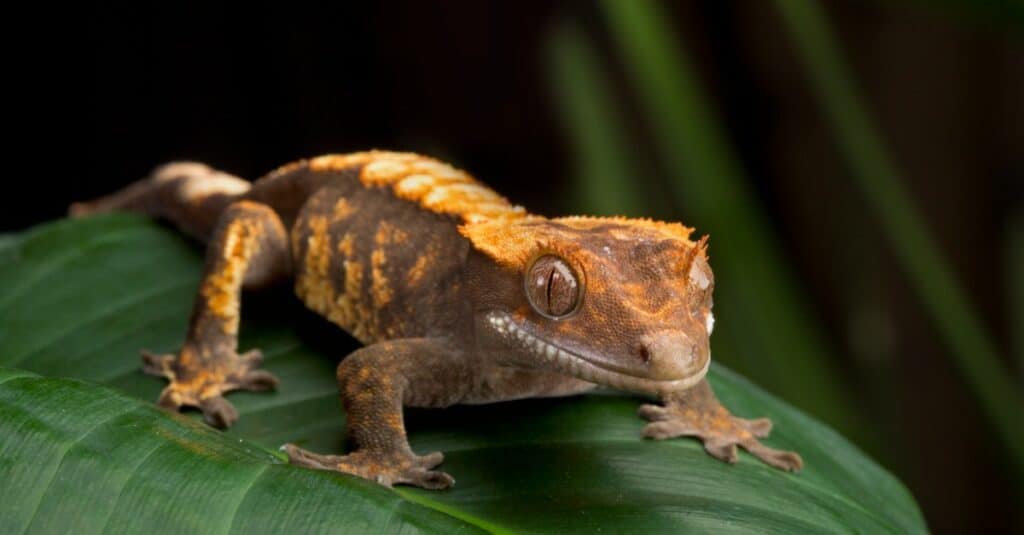From geckos’ bizarrely bulging eyeballs and slit-shaped pupils to the downright alien-looking peepers of chameleons, lizard eyes are incredibly unique. There are more than 5,000 distinct types of lizards, and they’ve evolved to have an array of different eye shapes, orientations, and sizes with various helpful adaptations perfectly suited for each species’ lifestyle.
Let’s take an in-depth look at what makes lizards’ eyes so fascinating, what their eyesight is like, and which species have the sharpest vision of them all.
Do Lizards Have Good Eyesight?

Lizards have surprisingly well-developed eyesight for reptiles.
©Valt Ahyppo/Shutterstock.com
In general, lizards tend to have very good eyesight. They rely primarily on their vision to find food and evade predators. In most regards, they can see just as well, if not better, than humans!
Lizards’ eyes can see colors that we can’t, and they can focus on objects up close and far away with ease. They even have a “third eye,” usually located atop the head, which helps to sense changes in light and darkness and regulate hormone production.
Of all the different types of reptiles, lizards likely have the best eyesight overall. For starters, they have unique photoreceptors in their eyes that allow them to see a wider range of colors than we can. This includes colors well into the UV range of the spectrum.
Lizards are also able to see with surprising clarity and definition! Most species can see well at a distance as well as up close thanks to their ability to flex the eye muscles around their lenses to focus on different objects. This allows their eyes to focus on and follow fast-moving objects or animals in motion, like predators looking to eat them or their own prey.
Notably, like humans and most other mammals, lizards’ pupils also expand and contract to allow in more or less light depending on the situation. The majority of lizards are diurnal and have average-sized, rounded pupils, while nocturnal species like geckos typically have slit-shaped or vertical pupils that are better suited for low-light conditions.
While lizards also rely partially on their senses of smell and hearing to survive, their sight is the most refined (and important) of the three.
Can Lizards See in Color?

Your
bearded dragon
can see more colors than you can!
©Zhitkov Boris/Shutterstock.com
Lizards can see in color. They can actually see more colors than humans! Lizards have four types of cone cells (while humans only have three) with unique photoreceptors that are especially sensitive to UV light. This allows them to see UV light and colors in the ultraviolet range.
The world looks a whole lot more vivid and colorful in the eyes of a lizard! This is because they are tetrachromats. Tetrachromat animals have four types of cone cells in their eyes. Trichromat animals have just three, dichromats have two, and monochromats have just one.
Most animals have either dichromatic or trichromatic vision, so the spectrum of colors they’re able to see is rather limited. Animals with tetrachromatic eyesight like lizards can see colors into the UV spectrum. This also includes some species of birds, fish, amphibians, and even some insects and mammals. Tetrachromacy also helps animals see better in low-light conditions, which is especially helpful for nocturnal lizards like geckos.
Do Lizards Have Night Vision?

Geckos have great night vision to suit their nocturnal lifestyle.
©iStock.com/jamcgraw
Most lizards are diurnal, so their eyesight is best suited for daytime lighting conditions. However, nocturnal species like geckos have excellent night vision. Their night vision helps them evade predators and spot prey even in very dark, heavily shaded conditions.
In general, lizards don’t have very great night vision, as they are most active during the day. When it comes to nocturnal geckos, though, their massive eyes and vertical, slit-shaped pupils are perfectly suited to the darkness. They can even see close-up details and focus on objects (or other animals) in motion in the dark!
During the day, geckos’ pupils stay tightly constricted to allow in only a tiny amount of light. This is to protect their sensitive eyes from harsh sunlight. At night, their pupils expand greatly, appearing more wide and circular to take in every last bit of light possible. Plus, thanks to their highly specialized cone cells, they can easily differentiate between colors even in pure darkness.
Do Lizards Really Have a “Third Eye?”

In most lizards, the parietal eye is located directly between the two primary eyes on top of the head.
©reptiles4all/Shutterstock.com
Lizards, as well as frogs, salamanders, and some fish, possess an organ known as a parietal eye, or a “third eye.” This “eye” is very small and primitive, but it is able to perceive changes in lighting and assists with the production of hormones and body temperature regulation. In most species, the parietal eye is a tiny, greyish pinhole-sized spot located directly between the eyes on top of the head.
Lizards do technically have three eyes! Just don’t expect to see a huge third eyeball jutting out of your bearded dragon’s head anytime soon. In truth, your lizard’s parietal eye is much, much smaller and less developed than their main two eyes they rely on for sight. In fact, you probably wouldn’t be able to see it without a magnifying glass, as it’s hardly larger than the head of a pin.
While the parietal eye can sort of “see” to an extent, it is mostly limited to picking up subtle changes in light and shade. The organ also regulates hormone production and thermoregulation. Efficient thermoregulation is especially important for ectothermic or “cold-blooded” animals like lizards who rely on external warmth to maintain their body temperature.
Interestingly, the parietal eye also serves as a sort of compass for many lizards! Since it can sense light, the third eye helps lizards orientate themselves and locate shelter, food, and familiar areas of their environment.
What Lizards Have the Best Eyesight?

Chameleons
have the best vision of all lizards by far.
©Kuttelvaserova Stuchelova/Shutterstock.com
Of all lizard species, chameleons have the most developed eyesight. Their eyes can move independently of each other, giving them an almost 360-degree field of vision. They can see well up close and at a distance and, like most lizards, are able to see a wide range of colors well into the UV spectrum.
While most lizards have quite good eyesight, chameleons are truly extraordinary. They can move each eye independently of each other, which allows them to see in virtually all directions. Chameleons often use their keen eyesight to assist with their camouflaging abilities.
Their deep-set eye sockets and large eyes have a wide range of motion. These globular eyes are protected by thick eyelids that cover everything but the lizard’s pupils. Chameleons can even switch between monocular and binocular sight at will! This means they can swap between looking at things with one eye at a time or both.
In short, chameleons’ eyesight is not just the best out of all lizards–their vision ranks among the best in the entire animal kingdom.
The photo featured at the top of this post is © Kuttelvaserova Stuchelova/Shutterstock.com
Thank you for reading! Have some feedback for us? Contact the AZ Animals editorial team.







